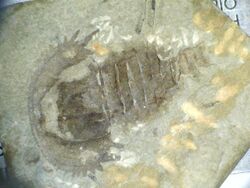Biology:Limuloides
From HandWiki
Short description: Genus of horseshoe crab relatives
| Limuloides | |
|---|---|

| |
| Specimen In 60018 of the species L. limuloides, located in the Natural History Museum in London | |
| Scientific classification | |
| Domain: | Eukaryota |
| Kingdom: | Animalia |
| Phylum: | Arthropoda |
| Subphylum: | Chelicerata |
| Clade: | Prosomapoda |
| Clade: | Planaterga |
| Family: | †Bunodidae |
| Genus: | †Limuloides Woodward, 1865 |
| Type species | |
| †Limuloides limuloides Woodward, 1865
| |
| Species | |
| |
| Synonyms | |
| |
Limuloides is a genus of synziphosurine, a paraphyletic group of fossil chelicerate arthropods.[1][2] Limuloides was regarded as part of the clade Planaterga.[1][3][4][5][2][6] Fossils of the genus have been discovered in deposits of the Silurian period in the United Kingdom and potentially in the United States . Limuloides is one of the two genera of the family Bunodidae, the other being the type genus Bunodes.[1][7][6] Limuloides is characterized by a carapace with radiated ridges and serrated lateral regions, and an opisthosoma with rows of nodes.[8][1] Limuloides was once though to have lateral compound eyes on its carapace, but later investigation did not find any evidence of it.[9]
References
- ↑ 1.0 1.1 1.2 1.3 Lamsdell, James C. (2013). "Revised systematics of Palaeozoic 'horseshoe crabs' and the myth of monophyletic Xiphosura". Zoological Journal of the Linnean Society 167 (1): 1–27. doi:10.1111/j.1096-3642.2012.00874.x. ISSN 0024-4082.
- ↑ 2.0 2.1 Bicknell, Russell D. C.; Pates, Stephen (2020). "Pictorial Atlas of Fossil and Extant Horseshoe Crabs, With Focus on Xiphosurida" (in en). Frontiers in Earth Science 8: 98. doi:10.3389/feart.2020.00098. ISSN 2296-6463. Bibcode: 2020FrEaS...8...98B.
- ↑ Selden, Paul A.; Lamsdell, James C.; Qi, Liu (2015). "An unusual euchelicerate linking horseshoe crabs and eurypterids, from the Lower Devonian (Lochkovian) of Yunnan, China" (in en). Zoologica Scripta 44 (6): 645–652. doi:10.1111/zsc.12124. ISSN 0300-3256. https://www.academia.edu/14633144.
- ↑ Lamsdell, James C.; Briggs, Derek E. G.; Liu, Huaibao P.; Witzke, Brian J.; McKay, Robert M. (2015). "A new Ordovician arthropod from the Winneshiek Lagerstätte of Iowa (USA) reveals the ground plan of eurypterids and chasmataspidids" (in en). The Science of Nature 102 (9–10): 63. doi:10.1007/s00114-015-1312-5. ISSN 0028-1042. PMID 26391849. Bibcode: 2015SciNa.102...63L. https://www.researchgate.net/publication/282127302.
- ↑ Bicknell, Russell D. C.; Lustri, Lorenzo; Brougham, Tom (2019-12-01). "Revision of "Bellinurus" carteri (Chelicerata: Xiphosura) from the Late Devonian of Pennsylvania, USA" (in en). Comptes Rendus Palevol 18 (8): 967–976. doi:10.1016/j.crpv.2019.08.002. ISSN 1631-0683.
- ↑ 6.0 6.1 Dunlop, J. A.; Penney, D.; Jekel, D. (2020). "A summary list of fossil spiders and their relatives". World Spider Catalog. Natural History Museum Bern. pp. 1–296. https://wsc.nmbe.ch/resources/fossils/Fossils20.5.pdf.
- ↑ Clarke, John Mason (1924). "A hemiaspidan crustacean from the New York Silurian waterlimes". New York State Museum Bulletin 254: 119–120. https://books.google.com/books?id=9JsWAQAAIAAJ.
- ↑ Eldredge, Niles; Smith, LeGrande (1974) (in en-US). Revision of the suborder Synziphosurina (Chelicerata, Merostomata) : with remarks on merostome phylogeny. American Museum novitates ; no. 2543. http://digitallibrary.amnh.org/handle/2246/2745.
- ↑ Bicknell, Russell D. C.; Amati, Lisa; Ortega-Hernández, Javier (2019-11-14). "New insights into the evolution of lateral compound eyes in Palaeozoic horseshoe crabs" (in en). Zoological Journal of the Linnean Society 187 (4): 1061–1077. doi:10.1093/zoolinnean/zlz065. ISSN 0024-4082. https://www.researchgate.net/publication/335016132.
Wikidata ☰ Q96387520 entry
 |

